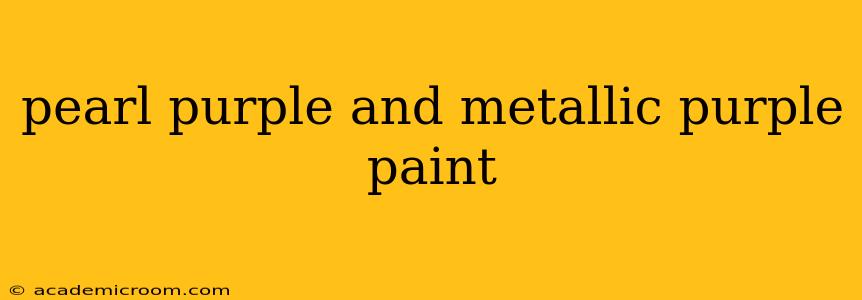Purple, a color associated with royalty, mystery, and creativity, finds its most captivating expressions in pearl and metallic finishes. These finishes transcend the standard solid purple, adding depth, dimension, and a captivating shimmer that elevates any project, from cars and motorcycles to walls and artwork. This guide delves into the nuances of pearl and metallic purple paints, exploring their differences, applications, and considerations for achieving the perfect finish.
What is Pearl Paint?
Pearl paint achieves its unique luminosity through the incorporation of microscopic mica flakes. These flakes, often coated with metallic oxides, diffract light, creating an iridescent effect that shifts subtly depending on the viewing angle. This shimmering quality is what sets pearl apart from solid or metallic finishes. The base color of the pearl paint influences the overall shade; a pearl purple, therefore, will have a deep purple base infused with this shimmering effect, resulting in a luxurious and ethereal appearance.
What is Metallic Purple Paint?
Metallic purple paint uses fine aluminum or other metallic pigments to create a sparkling, reflective finish. Unlike pearl, the shimmer in metallic paint is more consistent and less iridescent. It provides a bold, intense shine, often with a slightly coarser texture compared to the smoother finish of pearl. The intensity of the metallic effect can vary depending on the concentration of metallic pigments used.
What's the Difference Between Pearl and Metallic Purple?
The core difference lies in the type of pigment and the resulting effect. Pearl purple displays a more subtle, iridescent shimmer, shifting in tone as the light changes. Metallic purple boasts a brighter, more consistent sparkle, with a less subtle shift in color. Imagine pearl purple as a softly glowing twilight sky, while metallic purple resembles a brightly polished gem. This difference impacts the overall aesthetic; pearl lends a luxurious, sophisticated feel, while metallic exudes a bold, modern vibe.
What is the Best Purple Paint for Cars?
The best purple paint for a car depends on personal preference and the desired aesthetic. Pearl purple offers a refined, elegant look, often favored for classic or luxury vehicles. Metallic purple provides a more modern, eye-catching appeal, suitable for sports cars or custom builds. Factors like the car's body style, existing features, and overall design should also be considered.
What Type of Purple Paint is Best for Walls?
For walls, both pearl and metallic purple paints can add a striking visual element, although considerations differ. Pearl purple, with its softer shimmer, might be better suited for creating a calming and sophisticated ambiance, perfect for bedrooms or living rooms. Metallic purple, with its bolder shine, can add a dramatic touch to a feature wall or a room with a contemporary design. However, the high reflectivity of metallic paint might make a small room feel smaller; pearl paint, being more subtle, would be a better choice in such situations.
How Much Does Pearl and Metallic Purple Paint Cost?
The cost of pearl and metallic purple paints varies depending on several factors, including brand, quality, and the volume purchased. Generally, these specialty finishes are more expensive than standard solid colors due to the specialized pigments used. It's wise to obtain quotes from several paint retailers to compare pricing before making a purchase.
Where Can I Buy Pearl and Metallic Purple Paint?
Both pearl and metallic purple paints are available from various sources, including automotive paint suppliers, home improvement stores, and specialized paint retailers. For automotive applications, sourcing paint from a professional auto body shop is often recommended to ensure proper matching and application. For home use, major retailers like Home Depot or Lowe's will provide options, but researching specific brands known for quality pearl or metallic finishes is crucial for obtaining the desired result.
By understanding the nuances of pearl and metallic purple paints, you can make an informed choice that perfectly complements your vision and project. Remember to consider the desired level of shimmer, the overall aesthetic, and the specific application before making your final decision.
